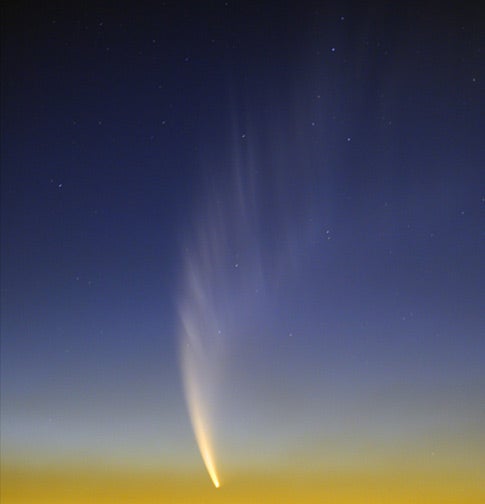NASA researchers and scientists from the United States, Germany and Japan have found a new mineral in material that likely came from a comet.
The mineral, a manganese silicide named Brownleeite, was discovered within an interplanetary dust particle, or IDP, that appears to have originated from comet 26P/Grigg-Skjellerup. The comet originally was discovered in 1902 and reappears every 5 years. The team that made the discovery is headed by Keiko Nakamura-Messenger, a space scientist at NASA’s Johnson Space Center in Houston.
“When I saw this mineral for the first time, I immediately knew this was something no one had seen before,” says Nakamura-Messenger. “But it took several more months to obtain conclusive data because these mineral grains were only 1/10,000 of an inch in size.”
A new method of collecting IDPs was suggested by Scott Messenger, another Johnson space scientist. He predicted comet 26P/Grigg-Skjellerup was a source of dust grains that could be captured in Earth’s stratosphere at a specific time of the year.
In response to his prediction, NASA performed stratospheric dust collections, using an ER-2 high-altitude aircraft flown from NASA’s Dryden Flight Research Center at Edwards Air Force Base in California. The aircraft collected IDPs from this particular comet stream in April 2003. The new mineral was found in one of the particles. To determine the mineral’s origin and examine other dust materials, a powerful new transmission electron microscope was installed in 2005 at Johnson.
“Because of their exceedingly tiny size, we had to use state-of-the-art nano-analysis techniques in the microscope to measure the chemical composition and crystal structure of Keiko’s new mineral,” says Lindsay Keller, Johnson space scientist and a co-discoverer of the new mineral. “This is a highly unusual material that has not been predicted either to be a cometary component or to have formed by condensation in the solar nebula.”
Since 1982, NASA routinely has collected cosmic and interplanetary dust with high-altitude research aircraft. However, the sources of most dust particles have been difficult to pin down because of their complex histories in space. The Earth accretes about 40,000 tons of dust particles from space each year, originating mostly from disintegrating comets and asteroid collisions. This dust is a subject of intense interest because it is made of the original building blocks of our solar system, planets, and our bodies.
The mineral was surrounded by multiple layers of other minerals that have also been reported only in extraterrestrial rocks. There have been 4,324 minerals identified by the International Mineralogical Association, or IMA. This find adds one more mineral to that list.
The IMA-approved new mineral, Brownleeite, is named after Donald E. Brownlee, professor of astronomy at the University of Washington, Seattle. Brownlee founded the field of IP research. The understanding of the early solar system established from IDP studies would not exist without his efforts. Brownlee also is the principal investigator of NASA’s Stardust mission.










